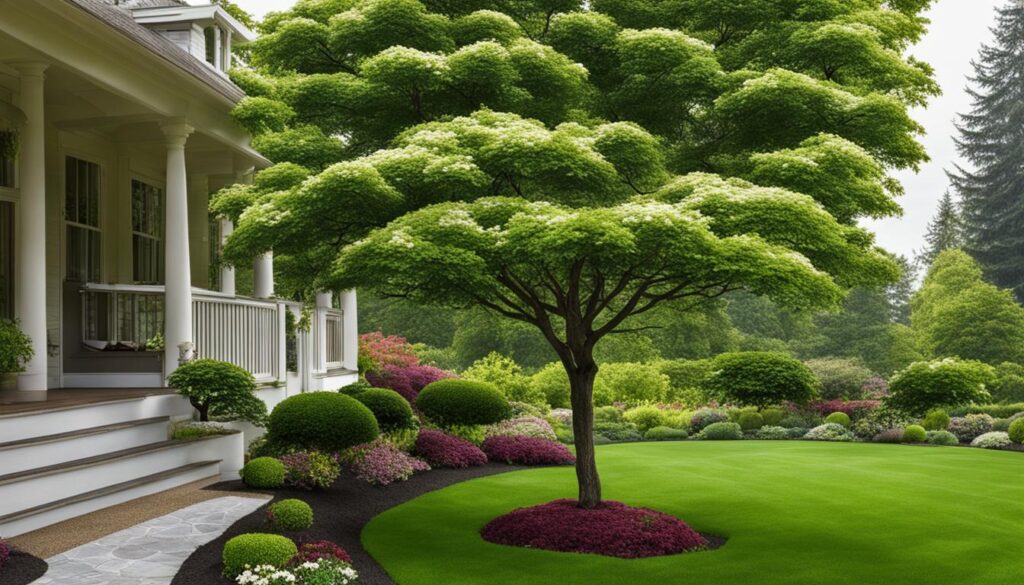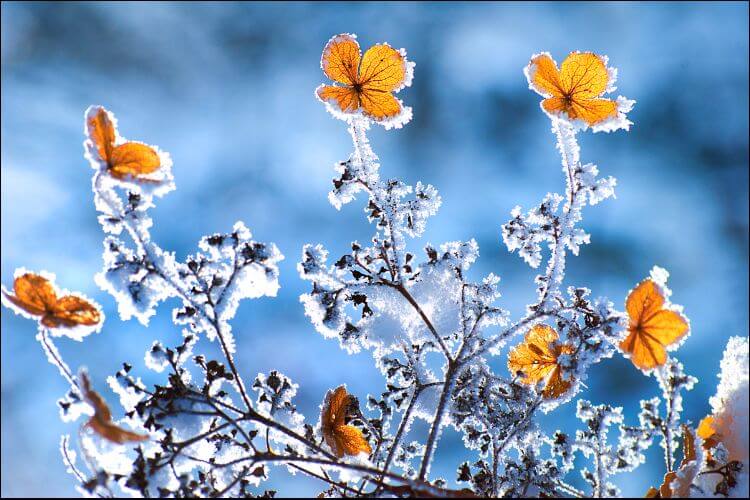When planting a dogwood tree, it is crucial to consider the distance from your house to ensure optimal tree health and enhance the aesthetics of your landscaping. According to the Missouri Botanical Garden, a well-developed and mature dogwood tree should be planted at least 15 feet away from the house. This allows the tree to reach its full growth potential and maximize its ability to create the illusion of a wider home.
Post Summary
- Plant your dogwood tree at least 15 feet away from your house for optimal tree health and landscaping aesthetics.
- Consider the long-term growth potential of the tree when selecting the planting spot.
- Ensure proper spacing between trees for future growth and avoid planting too close to structures such as patios and underground utilities.
- Dogwood trees require partial shade to full sun and well-drained, slightly acidic soil.
- Regular watering, minimal pruning, and protection from pests and diseases are essential for tree care.
Factors to Consider Before Planting
Before planting a dogwood tree, it is important to plan ahead and consider various factors. One key aspect to consider is cross-pollination. If you want your dogwood tree to bear fruit or produce flowers successfully, you need to ensure that a pollinator variety is present. Different dogwood varieties have different pollination requirements, so it’s essential to research and choose compatible varieties.
Another important consideration is the location. Dogwood trees thrive in sunny locations with well-drained and fertile soil. They require at least six to eight hours of sunlight per day to stay healthy and vibrant. It is also crucial to choose a planting spot with good drainage to prevent waterlogging and root rot.
Before planting your dogwood tree, assess the soil quality and make any necessary amendments. Dogwoods prefer moist, loamy soil with a slightly acidic pH level. Adding organic matter such as compost or peat moss can improve soil quality and provide essential nutrients for the tree’s growth.
“Proper planning and consideration of factors such as cross-pollination, sun exposure, and soil quality are vital for the successful growth of your dogwood tree. Take the time to research and choose compatible pollinator varieties, select a sunny location with well-drained soil, and prepare the planting site by improving the soil quality. By doing so, you can create an ideal environment for your dogwood tree to thrive and flourish.”
Factors to Consider Before Planting
| Factors | Considerations |
|---|---|
| Cross-pollination | Ensure a pollinator variety is present for fruit and flower production. |
| Sun and Soil Requirements | Choose a sunny location with well-drained and fertile soil. |
| Soil Quality | Assess and amend the soil for optimal growth conditions. |
Choosing the Right Planting Spot
When it comes to planting a dogwood tree, selecting the right spot is crucial as it can greatly impact the overall landscaping asset of your surroundings. Consideration must be given to factors like tree spacing and future plantings to ensure a harmonious and aesthetically pleasing landscape. Additionally, choosing a suitable planting spot involves assessing potential obstacles and incorporating the tree seamlessly into your existing design.
One key aspect to consider is tree spacing. By placing your dogwood tree in an area with enough room for its future growth, you can prevent overcrowding and allow each tree to thrive. This can be achieved by measuring the mature width of the dogwood variety you choose and ensuring there is sufficient space between each tree.
Another factor to keep in mind is the presence of any potential obstacles such as overhead wires or underground pipes. It is important to select a planting spot that avoids these obstacles to prevent any interference with the tree’s growth or damage to the infrastructure. Additionally, planting your dogwood tree in a location where it can be easily monitored from the house can provide added convenience and peace of mind.
Lastly, when choosing a planting spot, it is essential to plan for future plantings. Consider the layout of your landscape and ensure that there is enough space for additional trees or shrubs you may want to plant in the future. By carefully selecting the right planting spot, you can ensure that your dogwood tree becomes a beautiful and seamless addition to your landscape design.
| Factors to Consider | Details |
|---|---|
| Tree Spacing | Ensure sufficient space between trees for future growth |
| Potential Obstacles | Avoid overhead wires or underground pipes |
| Monitoring from the House | Plant where the tree can be easily observed |
| Plan for Future Plantings | Consider space for additional trees or shrubs |
Planting Distance Recommendations
When it comes to planting your dogwood tree, the distance you choose can have a significant impact on the overall health of the tree and surrounding structures. It is recommended to plant the tree at least 8-10 feet away from patios, water pipes, and sewer pipes. While patios generally don’t pose a problem due to the dry and compacted soil underneath, it’s important to provide enough space to prevent root intrusion into these areas. Sewer and water lines, although buried deeply, can attract root growth if the tree is planted too close, potentially causing damage.
| Structure | Recommended Planting Distance |
|---|---|
| Patios | 8-10 feet |
| Water Pipes | 8-10 feet |
| Sewer Pipes | 8-10 feet |
By following these recommended planting distances, you can ensure that your dogwood tree has ample space to grow without causing any harm to the surrounding structures. This not only protects your property but also allows the tree to thrive and reach its full potential. Remember to consider these planting distance recommendations during the initial planning phase to avoid any future issues that may arise.
“Providing adequate planting distance is crucial for the long-term health of your dogwood tree and the integrity of your property. By maintaining a safe distance from patios, water pipes, and sewer pipes, you can prevent any root-related problems and ensure a beautiful, stress-free landscape.” – Landscaping Expert
Spacing Between Trees
Proper spacing between dogwood trees is essential to ensure their healthy growth and prevent overcrowding. The recommended planting distances vary depending on the variety and growth habit of the trees. Here are the general guidelines for spacing between different types of dogwood trees:
Dwarf Varieties
Dwarf dogwood trees, which typically reach a height of around 3 to 5 feet, should be planted about 4 to 6 feet apart. These compact varieties are perfect for smaller gardens or spaces where a smaller tree is desired.
Semi-Dwarf Varieties
Semi-dwarf dogwood trees, which grow slightly taller than dwarf varieties, require a spacing of approximately 8 to 10 feet. These trees offer a good balance between size and visual impact and are suitable for medium-sized gardens.
Standard Varieties
Standard dogwood trees, known for their classic beauty and large size, should be planted about 15 to 20 feet apart. These trees can reach heights of 25 to 30 feet and are ideal for larger landscapes or as focal points in the garden.
Miniature and Colonnade Varieties
Miniature dogwood trees and colonnade dogwood trees, which have a narrow, columnar growth habit, should be spaced approximately 10 to 12 feet apart. These trees are great for adding vertical interest or creating natural screens, respectively.
Remember that these spacing recommendations are general guidelines and may vary depending on the specific cultivar and growth conditions. It’s important to consider the mature size of the tree and the overall design of your landscape when determining the spacing between dogwood trees.
Growing Conditions
When it comes to growing conditions, dogwood trees thrive in partial shade to full sun. It is important to ensure that your tree receives at least four hours of direct sunlight per day to promote healthy growth. Additionally, dogwood trees are adaptable to a wide range of soil types but prefer moist, loamy, slightly acidic soil.
To maintain the moisture levels in the soil, regular watering is essential, especially during dry spells. This helps prevent the shallow roots of the tree from drying out. It is recommended to water deeply, ensuring the water reaches the root zone. Applying a layer of mulch around the base of the tree helps retain moisture and regulates soil temperature.
Fertilization should be done sparingly for dogwood trees. It is advisable to apply a nitrogen-rich fertilizer in the second season after planting. This will provide the tree with the necessary nutrients for healthy growth without overstimulating excessive foliage or reducing flower production.
Pruning dogwood trees is generally done in late fall or winter when the tree is dormant. It is important to remove any dead or damaged branches to maintain the tree’s shape and overall health. By following these guidelines for sun and shade requirements, soil preferences, watering and fertilizing, as well as pruning recommendations, you can ensure the successful growth and maintenance of your dogwood tree.
| Growing Conditions | Description |
|---|---|
| Sun Requirements | Partial shade to full sun; at least 4 hours of direct sunlight per day. |
| Soil Preferences | Adaptable to a wide range of soil types; prefers moist, loamy, slightly acidic soil. |
| Watering Guidelines | Regular watering, especially during dry spells, to prevent shallow root drying; deep watering to reach the root zone. |
| Fertilizing Recommendations | Sparingly with a nitrogen-rich fertilizer in the second season after planting. |
| Pruning Recommendations | Done in late fall or winter when the tree is dormant; remove dead or damaged branches to maintain shape and health. |
Planting and Care Tips
Properly planting and caring for your dogwood tree is essential to ensure its healthy growth and longevity. Follow these tips to give your tree the best start and create a stunning addition to your landscaping.
Best Time to Plant
The best time to plant a dogwood tree is in the spring when the soil is moist and before the tree’s growth begins. This allows the roots to establish themselves before the hot summer months. Avoid planting during extreme weather conditions such as freezing temperatures or excessive heat, as these can stress the tree.
Planting Site Preparation
Before planting, choose a suitable site that provides dappled shade for your dogwood tree. Clear away any weeds or debris, and ensure the soil is well-drained. Dig a hole that is about two-thirds the depth of the root ball. Backfill the hole with soil while making sure the tree is slightly above ground level to prevent water accumulation around the trunk.
Mulching and Annual Fertilization
After planting, apply a layer of organic mulch around the base of the tree. Mulching helps retain moisture, suppresses weeds, and protects the tree’s roots from temperature extremes. Keep the mulch approximately 2-3 inches away from the trunk to prevent decay. Additionally, perform annual fertilization using an acid-rich fertilizer to support the tree’s growth and overall health.
Mulch Circle
Creating a mulch circle around your dogwood tree provides many benefits. The mulch circle helps conserve moisture, prevents soil compaction, and improves the aesthetic appeal of your landscape. Make sure the mulch layer is approximately 2-3 inches deep, extending at least 3 feet in diameter from the base of the tree. Avoid piling mulch against the trunk as it can lead to rot and other diseases.
Dogwood Tree Planting and Care Tips
| Tip | Description |
|---|---|
| Best Time to Plant | In spring, before the tree’s growth begins |
| Planting Site Preparation | Choose a site with dappled shade, clear weeds and debris, ensure well-drained soil |
| Mulching and Annual Fertilization | Apply organic mulch, keep away from trunk, fertilize annually with acid-rich fertilizer |
| Mulch Circle | Extend mulch approximately 3 feet in diameter from the base of the tree, 2-3 inches deep |
By following these planting and care tips, you can ensure the successful establishment and growth of your dogwood tree. Remember to monitor your tree regularly, providing proper watering and maintenance to keep it healthy and vibrant for years to come.
Growth Tips and Protection
When it comes to ensuring the healthy growth of your dogwood tree, there are several important factors to consider. By providing protection from excessive sun exposure and strong winds, proper watering, and pruning for shape, you can help your tree thrive. Additionally, it’s essential to be aware of potential pests and diseases that may affect your dogwood tree and take appropriate measures to prevent and manage them.
Protection from Sun and Wind
Excessive sun exposure can lead to sunscald and damage the bark of your dogwood tree. To protect your tree from the harsh sun, consider planting it in a location that provides some shade during the hottest parts of the day. You can also create shade using structures or by planting taller trees nearby.
Strong winds can cause damage to the branches and leaves of your dogwood tree. To provide protection from wind, consider installing windbreaks such as fences or planting hedges or other trees strategically around your dogwood tree. These barriers can help reduce the impact of strong winds and prevent injury to your tree.
Proper Watering
Proper watering is crucial for the health of your dogwood tree, especially during dry spells. Dogwood trees have shallow roots, so it’s important to water them regularly to prevent drying out. Aim to provide a deep and thorough watering once a week, ensuring that the soil is moist but not waterlogged. Mulching around the base of the tree can help retain moisture and reduce water evaporation.
Pruning for Shape
While pruning for shape is not necessary for the health of your dogwood tree, it can help maintain a desirable appearance and remove any dead or damaged branches. The best time to prune your dogwood tree is during late fall or winter when the tree is dormant. Be sure to use sharp and clean pruning tools to make precise cuts and minimize the risk of disease transmission.
Potential Pests and Diseases
Dogwood trees are susceptible to various pests and diseases, including bark borers, powdery mildew, and anthracnose. Regularly inspect your tree for any signs of pest infestation or disease, such as holes in the bark, wilting leaves, or unusual discoloration. If you notice any issues, consult with a professional arborist or horticulturist for proper identification and treatment options.
By implementing these growth tips and protection measures, you can ensure the healthy development of your dogwood tree and enjoy its beauty for years to come.
Conclusion
In conclusion, planting your dogwood tree at the recommended distance from your house, which is approximately 15 feet, is crucial for both tree health and landscaping aesthetics. By following this guideline, you allow your tree to reach its full growth potential and create the illusion of a wider home, enhancing the overall appeal of your landscape.
When planting your dogwood tree, it is important to consider various factors such as cross-pollination, sun and soil requirements, and proper planting and care techniques. Ensure that a pollinator variety is present for successful fruiting or flowering, provide sufficient sunlight and well-drained soil for optimal growth, and follow the recommended planting and care tips to maintain the health and longevity of your tree.
Remember to regularly monitor and protect your dogwood tree from excessive sun exposure and strong winds. Proper watering, pruning for shape, and awareness of potential pests and diseases are also necessary for maintaining a healthy and stress-free tree. By implementing these care tips, you can ensure the successful growth and beauty of your dogwood tree for years to come.
Can I Plant My Dogwood Tree Near a Holly Tone-fertilized Area?
Yes, you can plant your dogwood tree near a Holly Tone-fertilized area. Holly tone for dogwood trees can provide the necessary nutrients for healthy growth. Just make sure to follow the recommended dosage and keep an eye on the tree’s health.
FAQ
How far should I plant a dogwood tree from my house?
It is recommended to plant a dogwood tree at least 15 feet away from your house to promote optimal tree health and enhance the aesthetics of your landscaping.
What factors should I consider before planting a dogwood tree?
Before planting a dogwood tree, it is important to consider cross-pollination, sun and soil requirements, and location considerations to ensure successful tree growth.
How do I choose the right planting spot for my dogwood tree?
When choosing a planting spot for your dogwood tree, consider its surroundings and future growth, including tree spacing and future plantings, to create a beautiful and well-planned landscape.
What are the recommended planting distances for dogwood trees?
The recommended planting distances for dogwood trees depend on their variety and growth habit. It is important to plant at a safe distance from patios, water, and sewer lines to prevent root intrusion and potential damage.
How much space should I leave between dogwood trees?
The spacing between dogwood trees depends on their variety and growth habit. Leave enough space between trees to accommodate their additional growth and ensure optimal tree health.
What are the growing conditions that dogwood trees prefer?
Dogwood trees thrive in partial shade to full sun, prefer well-drained and fertile soil, and require regular watering to prevent shallow root drying. Fertilization and pruning should be done sparingly to maintain the tree’s health.
What are some planting and care tips for dogwood trees?
The best time to plant a dogwood tree is in the spring before tree growth begins. Prepare the planting site, mulch around the trunk, and provide annual fertilization and a mulch circle. Regular watering and pruning for shape are also important.
How can I ensure the healthy growth of my dogwood tree?
Protect your dogwood tree from excessive sun exposure and strong winds, provide regular watering, and remove dead or damaged branches. Be aware of potential pests and diseases and maintain a healthy and stress-free tree.
What are the benefits of planting a dogwood tree at the recommended distance from my house?
Planting a dogwood tree at the recommended distance of 15 feet from your house promotes optimal tree health and enhances the aesthetics of your landscaping by creating the illusion of a wider home.













